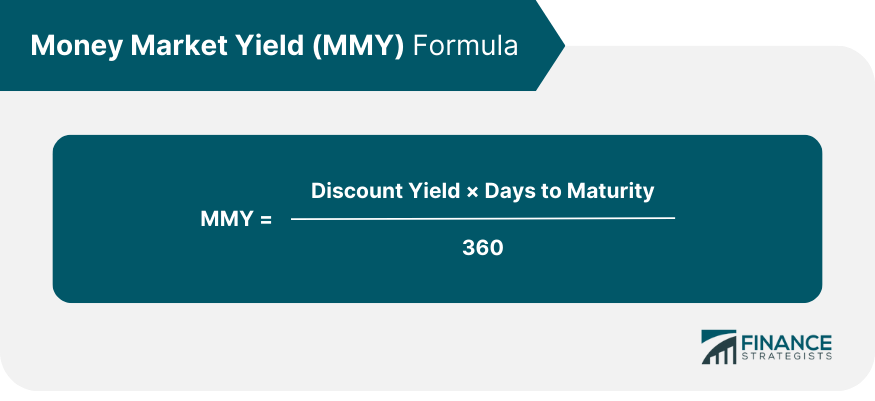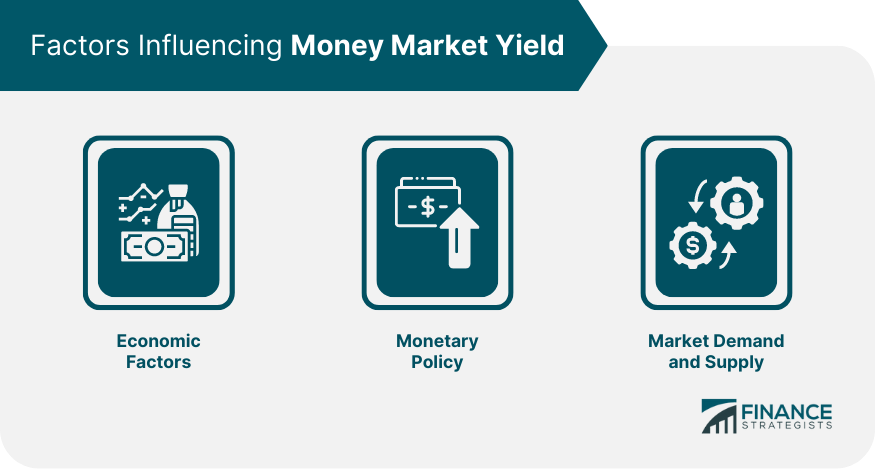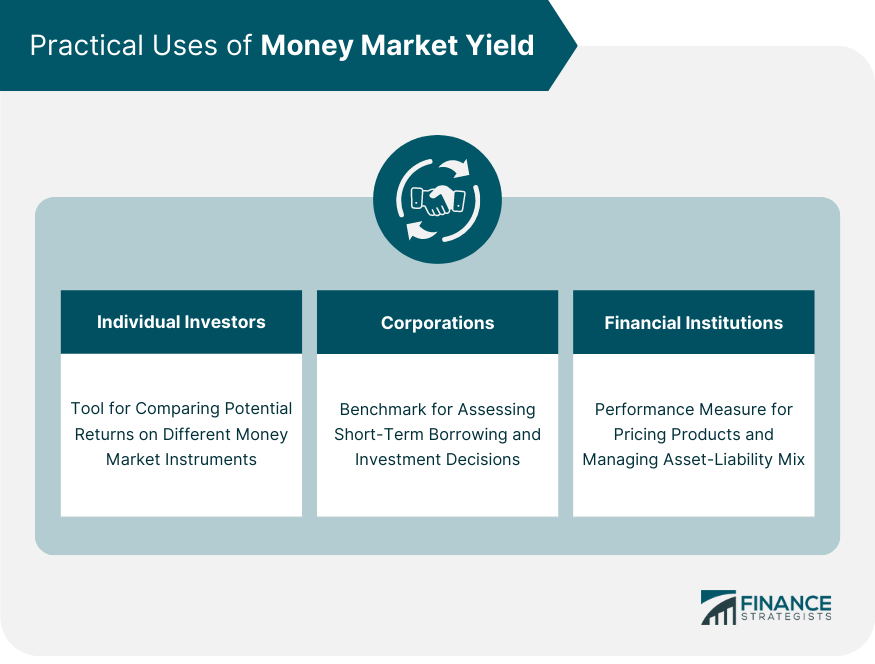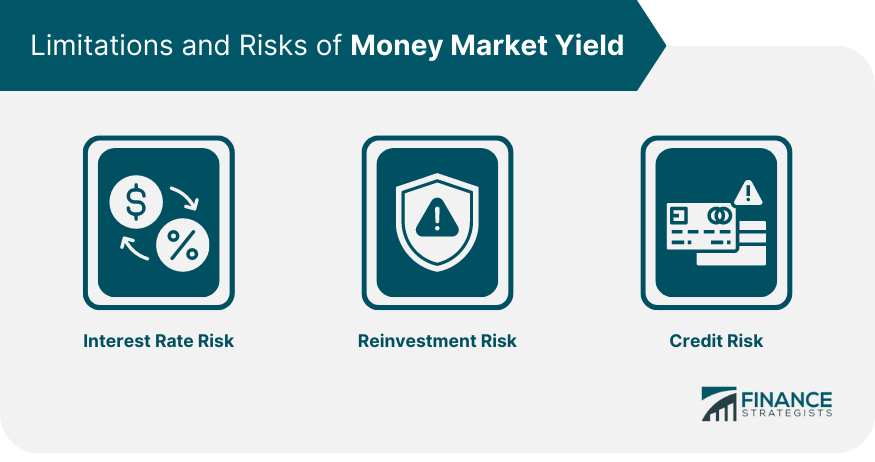Money Market Yield refers to the annualized yield or return earned by an investor on a money market instrument, such as Treasury bills, commercial paper, or Certificates of Deposit (CDs). It is calculated by dividing the instrument's annualized interest income by its current market price or face value. The purpose of calculating the money market yield is to provide investors with a standardized measure of the return they can expect from short-term, low-risk investments in the money market. This yield metric allows investors to compare the relative attractiveness of different money market instruments and make informed investment decisions based on their desired risk-return tradeoff. The "Discount Yield" is the difference between the purchase price and the face value of the instrument, divided by the face value. "Days to Maturity" is the remaining days left for the instrument to mature. Comparing Money Market Yield to Other Yields The MMY is often compared to other yields, such as the Bond Equivalent Yield (BEY) and the Certificate of Deposit Equivalent Yield (CDEY), for investment decision-making. While the MMY is based on the discount from the face value, the BEY is based on the instrument's purchase price. The CDEY, on the other hand, assumes compounding, which is not a feature of MMY or BEY. Several economic factors influence the MMY. Macroeconomic indicators such as inflation, GDP growth, and unemployment rates can impact the demand and supply of money, thereby affecting yield. Monetary policy decisions of central banks play a crucial role in influencing the MMY. For instance, when a central bank raises interest rates, the yield on new money market instruments increases. Conversely, when interest rates are cut, the yield decreases. The demand and supply dynamics of money market instruments also impact the MMY. When there is high demand for these instruments, the yield tends to decrease, and when the demand is low, the yield increases. For individual investors, MMY serves as a tool to compare the potential return on different money market instruments. It helps them make informed decisions and pick the instrument that provides the best return for a given level of risk. Corporations use MMY as a benchmark to determine the viability of their short-term borrowing and investment decisions. It aids in managing their cash flow efficiently and finding the optimal balance between risk and return. For financial institutions, MMY is a critical metric for assessing the performance of various money market instruments. It helps them in pricing their products competitively and managing their asset-liability mix effectively. Interest rate risk refers to the potential for an investment's value to decrease due to changes in the overall interest rates. If interest rates rise, the prices of existing money market instruments fall, reducing their yield. Reinvestment risk is the risk that future cash flows from an investment might have to be reinvested at a potentially lower rate of return. This is particularly relevant when the money market yields are declining. While the money market is generally considered safe, it's not entirely free from credit risk. There's a risk that the issuer of a money market instrument may default on their repayment obligation, particularly in the case of corporate issuers. Including money market instruments in a portfolio can help diversify risks, particularly in volatile market conditions. They can provide a stable return and preserve capital, making them a suitable choice for risk-averse investors. Money market yields play a role in both passive and active investment strategies. Passive investors may hold money market instruments to balance riskier investments, while active investors may trade them to capitalize on interest rate fluctuations. The inclusion of money market instruments can impact the overall portfolio yield. Depending on the prevailing money market yields, they can either enhance or dilute the portfolio yield. Central bank policies significantly influence money market yields. When a central bank infuses liquidity into the system (through rate cuts or open market operations), it puts downward pressure on money market yields. Conversely, when it tightens liquidity, money market yields tend to rise. Money market yields are closely watched economic indicators. They reflect the cost of short-term borrowing in the economy and provide insights into the market's expectations about future monetary policy and economic conditions. Money Market Yield (MMY) provides a key metric for determining the annualized return on short-term, high-liquidity investments. Its calculation, influenced by a range of factors, including economic indicators and monetary policy decisions, is vital to comprehend the overall financial landscape. Furthermore, MMY has practical applications that extend to individual investors, corporations, and financial institutions alike. For individuals, it helps compare potential returns, guiding informed investment decisions. Corporations find MMY useful for assessing their short-term borrowing options, while financial institutions use it as a performance measure for their product offerings. Therefore, understanding MMY not only provides insights into the dynamics of the financial market but also equips stakeholders with a crucial tool for navigating their financial journey.Definition of Money Market Yield
How Money Market Yield is Calculated

Factors Influencing Money Market Yield
Economic Factors
Monetary Policy
Market Demand and Supply

Practical Uses of Money Market Yield
For Individual Investors
For Corporations
For Financial Institutions

Limitations and Risks of Money Market Yield
Interest Rate Risk
Reinvestment Risk
Credit Risk

Money Market Yield in Portfolio Management
Role in Diversification
Inclusion in Passive and Active Investment Strategies
Impact on Portfolio Yield
Money Market Yield and Monetary Policy
Effect of Central Bank Policies on Money Market Yield
Role of Money Market Yield in Economic Indicators
Conclusion
Money Market Yield FAQs
Money Market Yield (MMY) is a formula used to calculate the annualized yield of a money market instrument based on its discount rate and the number of days to maturity. It is important because it allows investors, corporations, and financial institutions to compare the returns on different money market instruments, aiding in decision-making processes.
Money Market Yield is calculated using the following formula: MMY = (Discount Yield x Days to Maturity) / 360. The "Discount Yield" is the difference between the purchase price and the face value of the instrument, divided by the face value. "Days to Maturity" is the remaining days left for the instrument to mature.
Money Market Yield is influenced by various factors, including economic indicators (like inflation, GDP growth, and unemployment rates), monetary policy decisions made by central banks, and the demand and supply dynamics of money market instruments in the market.
Despite its utility, Money Market Yield comes with certain risks, including interest rate risk (the potential for an investment's value to decrease due to changes in overall interest rates), reinvestment risk (the risk that future cash flows from an investment might have to be reinvested at a potentially lower rate of return), and credit risk (the risk that the issuer of a money market instrument may default on their repayment obligation).
Money Market Yield plays a significant role in portfolio management. It helps in diversifying risks, is included in both passive and active investment strategies, and impacts the overall portfolio yield. The inclusion of money market instruments, depending on the prevailing money market yields, can either enhance or dilute the portfolio yield.
True Tamplin is a published author, public speaker, CEO of UpDigital, and founder of Finance Strategists.
True is a Certified Educator in Personal Finance (CEPF®), author of The Handy Financial Ratios Guide, a member of the Society for Advancing Business Editing and Writing, contributes to his financial education site, Finance Strategists, and has spoken to various financial communities such as the CFA Institute, as well as university students like his Alma mater, Biola University, where he received a bachelor of science in business and data analytics.
To learn more about True, visit his personal website or view his author profiles on Amazon, Nasdaq and Forbes.











